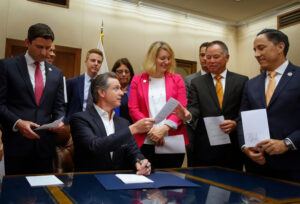September 29, 2022
Topic
Through the California Resilience Partnership (CRP) and with philanthropic support from the Conrad N. Hilton Foundation, Resilient Cities Catalyst, Farallon Strategies, and CivicWell recently released the report Climate Crossroads: California’s Readiness to Act on Climate Resilience.
The report is a landscape analysis with recommendations to inform the State’s grant programs to foster more equitable and resilient communities across California.
Timely Recommendations for a Crucial Moment
According to CRP co-chairs Sona Mohnot and Emily Young, PhD, “The report details where we are and how far we need to go in order to build systems that will be able to manage and adapt in these turbulent times. And the stakes are very high. We have a generational opportunity to right historical wrongs, setting up our communities for success in the decades to come.”
CivicWell’s Climate Change and Energy Program Director Julia Kim echoes the urgency. “We are all too familiar with the challenges we face as resilience practitioners and community leaders— ongoing capacity constraints, barriers to accessing funding, and inequitable systems that stand in the way of community-driven solutions and self-determination,” she states. “Climate Crossroads is a reflection of our collective experiences and a stepping stone to improving funding structures to maximize this once-in-a-generation opportunity for California communities.”
Helping Stakeholders Foster Community Resilience
Following the adoption of the State’s 2021 budget and the historic $3.7 billion package for climate resilience, this initiative aimed to understand climate resilience funding gaps, needs, and opportunities to offer targeted recommendations to the State’s grantmaking agencies. The ultimate goal of Climate Crossroads is to create a funding environment that can help stakeholders foster long-term resilience in the communities where these dollars are needed the most.
The CRP team conducted data analysis to surface learnings from previous grant programs and engagement resources, and engaged with hundreds of local, regional, and statewide community resilience leaders. Additionally, a working group of leaders driving equity and resilience in cross-sectoral organizations across the state provided guidance via a series of working meetings.
Recommendations Aim to Maximize Impact
These perspectives led to six core recommendations. Mohnot and Young see them as crucial and timely: “We could look back a decade from now and realize that in our desire to seize the moment and urgently act we spent billions of dollars in the wrong places and on the wrong projects. The way to avoid this disastrous outcome is for all of us to follow the recommendations detailed in this report.”
According to the report, the core recommendations “speak to a broader opportunity for a paradigm shift in how we resource communities to come together and act in the face of climate change.” Each recommendation is supported by a case study as well as several practical and applicable key actions for both immediate and long-term solutions. The recommendations are as follows:
- Overhaul existing grant processes and structures to increase funding accessibility and ensure equitable activation of climate resilience statewide.
- Fund core climate resilience staff capacity.
- Environmental justice networks and community-based organizations should have dedicated resources to create authentic, meaningful, and culturally competent community-led resilience efforts.
- Climate resilience support should defer to regional self-organization approaches to ensure activities reflect local goals, resources, and constituents.
- Existing state policy levers should be utilized to augment existing local capacities, resources, and momentum.
- Funding information and outcomes should be more consistent, transparent, and accessible to ensure more equitable allocation.
Read the Full Report.
The CRP team has been meeting with a number of state agencies to share the report’s findings and to better understand barriers and opportunities to advancing these recommendations. If you are interested in learning more or supporting this effort:
- Stay tuned for a statewide webinar on the report’s findings, recommendations, and next steps (to be scheduled for October or November).
- Support recommendations that resonate with you in comment letters, particularly those in response to draft grant guidelines.
- Share the report with your network to help these recommendations gain traction.

Policy Corner
Climate Is On the Ballot in November
So far, the Fall has been a time of action on climate change both at the federal and state levels. Not long after President Biden signed the Inflation Reduction Act (IRA) into law, Governor Newsom followed suit by signing a host of far-reaching climate bills that accelerate California’s push to reach carbon neutrality no later than 2045.
SB 852, authored by Senator Bill Dodd and co-sponsored by CivicWell and Insurance Commissioner Ricardo Lara, which authorizes local governments to establish climate resilience districts to plan, finance, and implement climate mitigation and adaptation projects, was among the nearly four dozen bills the Governor approved. But do the voters also have a say on climate issues in the upcoming November 8 election? The answer is a resounding yes.
One of the eight initiatives on the state ballot is Proposition 30, which would levy a 1.75% tax on Californians who have an annual income greater than $2 million to fund zero emission vehicles and charging infrastructure along with wildfire prevention and response. The estimated $3.5 to $5 billion generated each year would be allocated as follows:
- Approximately 75% of the funding would be designated for rebates to those purchasing zero emission vehicles and to expanding charging infrastructure. Half of this funding would go to low- and middle-income residents who suffer a disproportionate impact of pollution and poor air quality.
- About 25% of the funding would be designated to hire and train firefighters to battle the state’s growing wildfires.
The state has made meeting the climate crisis and reducing greenhouse gas (GHG) emissions a leading priority. In addition to reaching carbon neutrality by 2045, in the interim, existing law calls for a 40% reduction from 1990 GHG emissions levels by 2030 and an 80% reduction in GHG emissions by 2050.
Nearly 50% of GHG emissions come from the transportation sector in California, and dramatic action must be pursued. While major steps have been taken to phase out the sale of new fossil fuel light duty vehicles by 2035, and proposed to end the sale of new fossil fuel heavy duty vehicles by 2045, the transition to zero emission vehicles will require significant resources to accomplish these steps without major social or economic disruption. Proposition 30 will substantially boost state funding to support that critical transition, especially making it affordable to those of modest means.
Recent years have brought increasingly devastating and catastrophic wildfires to California. In 2020, more than 8,000 wildfires scarred nearly 4.4 million acres and in 2021, more than 7,000 wildland fires scorched nearly 2 million acres. Five of the seven largest wildfires in the state’s modern history burned at the same time in 2020 and the single largest wildfire—the August Complex fire in 2020—burned more than one million acres. The Dixie Fire in 2021 covered more than 750,000 acres. Tens of thousands of homes have been reduced to rubble, billions of dollars of insured losses have occurred, hundreds of lives have been lost, and prime habitat has been laid waste. Firefighters are too few and stretched too far. Proposition 30 will add significant new funding to help bulk up wildfire prevention and response.
Climate is also on the ballot for voters as they determine hundreds of federal, state, and local legislative offices. To maintain the momentum for addressing the climate crisis, electing candidates who will prioritize aggressive action at all levels of government is essential. Especially with the control of Congress hanging in the balance, several key races in California could play a deciding role in whether the federal government builds on the IRA to take critical action on a national scale.
Be informed, be an advocate, and vote!
Board Highlight

City of Riverside Recognized for Having #1 Green Fleet in North America
NAFA Fleet Management Association (NAFA), the vehicle fleet industry’s largest membership association, awarded the City of Riverside with first place in its annual Green Fleet Awards. The City of Long Beach, CA Fleet Services was recognized as the second place fleet; and the City of Dublin, OH earned third place.
The Green Fleet Awards recognize fleet sustainability efforts and honor fleets that have enhanced practices to make a positive impact on the environment. The awards emphasize cities’ commitment to the use of alternative fuel and hybrid vehicles, fuel usage and savings, purchasing policy, long-range planning, and community outreach among other areas.
Riverside City Councilmember Ronaldo Fierro stated, “This milestone shows how our city is not just talking about sustainability, but making major strides toward achieving it.”





